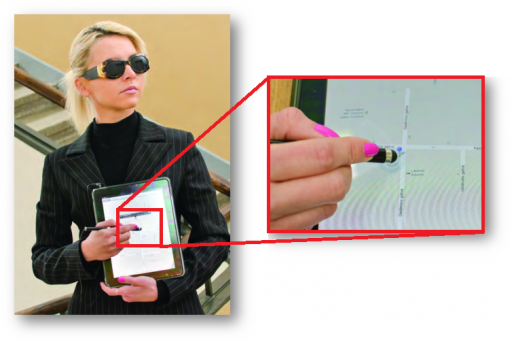Tactile device for blind or visually impaired to “see” the surrounding environment by touch
Our current technology is a device for the blind and visually impaired. Our solution will help these individuals to perceive 2D graphic objects and colors by tactile feedback and/or sound. The image component is a typical tablet, PC or smartphone including proprietary software. A digital pen with a piezoelectric transducer/vibrator provides tactile and audible feedback. The software which comes with the device accomplishes several functions: (a) filtering of the image, accentuating the contours of the typical elements (doors, tables, street, etc.); (b) transforming the 2D graphics or images into electrical signals with their amplitude and frequency related to specific color or intensity of contour.
Market need / Problem
It is unsafe and problematic for blind or visually impaired people to be alone. They can’t easily navigate their surroundings and must remember the location of all aspects of their everyday life. There are of course signs and information in Braille, canes etc. However there is a need for a more sophisticated solution that incorporates modern day technologies.
How it works
What if blind or visually impaired individuals had the ability to receive information from a distance without touching any specific objects? It would be great. Our solution provides an opportunity for people to integrate into society and helps them to use the same type of touch screen mobile devices as other people do. It is multidisciplinary solution that has universal appeal regardless of language and culture.
This technology could also be adopted for child learning – they could imagine shapes, contours and receive information about colors or same color intensity.
Market overview and Competition
he market has for example the Full Graphical Array (128x64 dots) manufactured by Smart Technology Limited, Birmingham, UK. It displays simple refreshable tactile graphics using Braille pins but is rather bulky and needs approximately 10 seconds for a complete refresh. There are also zoom functions and Braille to text options available but the resolution of dots (2.5mm between Braille pins) is too low to comprehend more complicated 2D graphics.
The proposed device creates a totally new market for low cost displays, especially when none of the existing screen readers are suitable for the design of hand-held portable devices. The advantage of developed system is that typical components (tablet PC, e.g. in a form of iPad and Digital pen with incorporated piezoelectric transducer) are used together with special software for image processing and active contour segmentation. The attractive feature of proposed device is relatively low cost for this class of devices and easiness of use in dealing with typical situations for blind and visually impaired.



